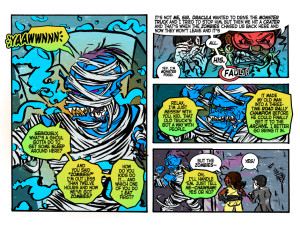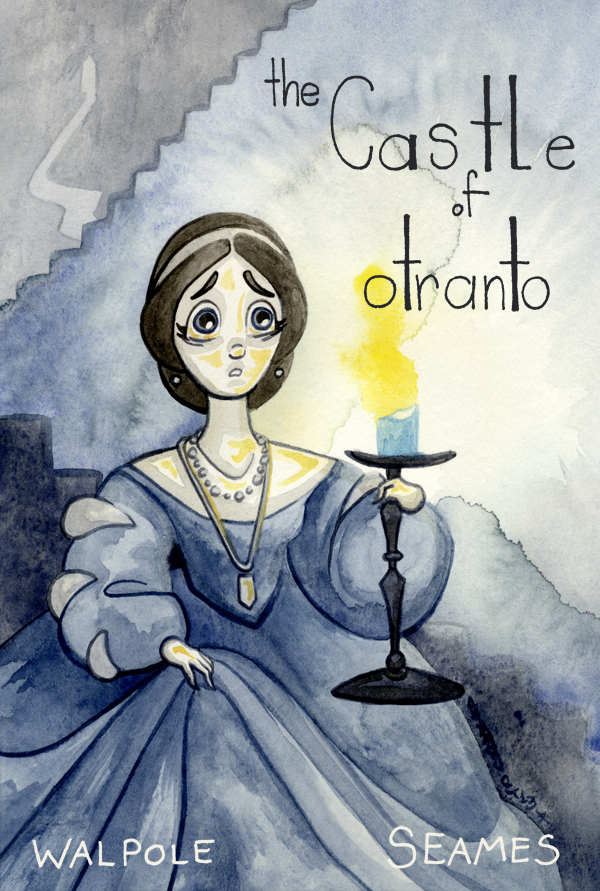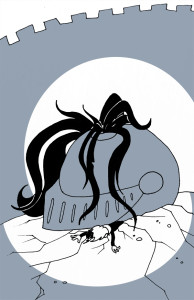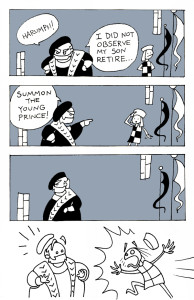JoJo Seames, known for her work on webcomics like The Makeshift Man and Monster Plus, is embarking on a months-long effort to adapt The Castle of Otranto by Horace Walpole, credited as the original Gothic novel, into comics form. Otranto is the story of Manfred, lord of Castle Otranto, whose son Conrad is mysteriously crushed to death by a giant helmet on his wedding day, and Isabella, Conrad’s betrothed, who is horrified when her would-be father in law announces his intention to marry her instead. The comic is being published for free on tumblr, one page every weekday, and is well worth your time. I had the opportunity to interview Ms. Seames about Otranto, horror, and her career in comics.
Dylan Roth: How’d you first become aware of the source material for your comic?
JoJo Seames: I love classic literature. Like, my go-to source of reading enjoyment is to pick out something from the 18th or 19th century. Found myself with a copy of The Castle of Otranto on my shelf ’cause my husband had it from a college literature class. And I’m not NOT gonna read that. It’s the first Gothic novel. It’s got ghosts!
DR: What inspired you to translate Otranto to comics form?
JS: I think in a very visual way. Any time I’m reading something, I picture it all in my head the way I would draw it. I basically want to illustrate everything I ever read! Ha!
DR: What was it about Otranto in particular, rather than one of your other gothic horror favorites? Was it its relative obscurity?
JS: Obscurity, yes. I’m so surprised that there haven’t been dozens upon dozens of movie and comic adaptations of it. Also, and importantly: it is very short It’s, like, 90 pages long. So adapting the whole story seemed very…possible. Not too daunting a work to take on… [The comic will total in] the 400-500 comic page range? That would be my rough estimate. Page 50 is where I think it starts to get REALLY interesting.
DR: That image of Conrad beneath the helmet is a very striking, memorable visual that seems perfectly suited for comics.
JS: Right? How am I the first person who’s doing this? Droppin’ the ball, there, Pop Culture As A Whole.
DR: What has been your process for adapting a book to graphic form? Do you write a script or do you go directly to art?
JS: With this project in particular, my goal for myself is to not overthink the process. So I’m actually not even thumbnailing. I draw three pages at a time, and I just open up the book, read and re-read the particular part I’m at, and then draw what’s happening. The most planning ahead I’m doing has been relating to what order to show scenes in, if there’s two things going on simultaneously. There’s some of that going on at the end of chapter 1, where I don’t want to have to backtrack to what a character was doing before a scene we’ve already gone through.
DR: Have you taken any liberties with the original story? How faithful has your adaptation been?
JS: Super faithful! I’ve tried to make this as unabridged an adaptation as possible. So all the dialogue and prose is direct from the novel, except for a couple parenthetical asides, where I’m kind of summarizing for brevity’s sake.
DR: Your take on The Castle of Otranto has a very simple, minimalist cartoon style, in black and white, with only one additional color, that pale blue. Did you always know the comic would look the way it does, or did you experiment with a few different ideas?
JS: …I always knew I wanted it drawn in that minimal way, and then adding another tone would let me indicate when a scene was dark or if there was dramatic torchlight or something. And a lot of the story involves running down dark passages, so the aura of darkness was important.
DR: It is a gothic novel, after all.
JS: Right. And the minimal style seemed an obvious way to keep the kind of sardonic tone of the book. There’s a level of distance between the reader and the events that draws a little more focus to the TELLING of the story, rather than just the situations themselves. Less…I want to say emotional realism? (Bonus: Easier to draw?!)
DR: Characters, particularly Manfred, sort of transform depending on the tone of the scene – more detailed when he’s meant to be menacing, like when he explains his plan to marry Isabella, or more simple and cartoonish, like early on when he’s being sort of silly and impatient.
JS: Yeah, that’s intentional. He changes size, too, when I want him to be more threatening. I also use less prose when I want it to be more serious, so there’s less of that emotional distance. Let you get lost a little bit in Isabella’s emotions So that this stays a horror story.
DR: Let’s talk about some of your other projects. What else are you working on?
JS: The big one is The Abettor’s Letters, an indie video game from Beach Interactive. It’s a point-and-click RPG for iPad — a spy story, that teaches you French as you play! My role on the project is Character Artist, which means designing and illustrating all the characters and interactive objects, storyboarding and illustrating animatic cutscenes, promotional art, and otherwise being part of the story and design team with a say on every aspect of how the game works. So it’s a pretty big job.
DR: How do you like doing design work on a big project like that, compared to comics work?
JS: There are pros and cons to both. Working on a team is AMAZING, with the way we all push each other and suggest ways to make the project better and better. And there’s so much motivation to get things done and make them the best, because no one wants to be a weak link in the chain, or inconvenience anyone else, because we see how hard each other are working. And there’s such a feeling of accomplishment on a big project. BUT big projects take a long time to get done. Comics can be done so relatively quickly, and the way they can be a totally solitary pursuit also allows for them to be such a personal, intimate thing. There’s an immediacy, both in the sense of a time frame, and also on an emotional level.
Not that Otranto is particularly personal. I didn’t write it, so it’s still a sort of collaborative process…but with a partner who’s completely silent. That’s how I think of Otranto. It’s not “my”comic, it’s still “our” comic, even though Horace Walpole and I have obviously never directly communicated.
DR: I’d like to shift to more general questions for a bit. What draws you to horror stories?
JS: I like the way they work on a symbolic level to talk about our most primal feelings. Feelings so strong we can’t deal with them directly. I think that’s fascinating.
DR: What kind of advantages and limitations do you your think the comics form has in telling horror stories?
JS: It’s really hard to draw a comic that’s actually, ya know, scary. The reader controls the pacing, so you can’t jump out at them with a shock. It’s silent, so you can’t make spooky sounds or leave spooky silences. You can’t draw something they see for only an instant, leaving them wondering if they actually saw anything at all. So you have to take entirely different tactics. You have to work by suggestion, and deal in the CONCEPTS of horror. Use atmosphere. Use any tool where you’re going to LINGER on an image, or a thought. You have to work with the reader’s ability to fill in the gaps, themselves, and work with the power of suggestion. So it’s challenging. At the same time, there’s a lot of power in a piece of visual art. It’s the best for things like body horror, or dealing with the grotesque or bizarre, those times when dwelling on something just makes it more and more horrific.
DR: Who do you think does horror comics best? Do you have favorites, influences, books you go back and reread?
JS: Emily Carroll immediately comes to mind for that creepy, suggestive kind of horror. Junji Ito is the master of that grotesque kind that scares you more and more the longer you look at a drawing.
DR: You offer The Castle of Otranto for free, but is there any way your readers and fans can support your work?
JS: I have SO MUCH original art for sale! SO MUCH! And I have prints and t-shirts and things! And I’m pretty much always open for commissions!
DR: Are you in the midst of publishing anything else that we should be reading?
JS: Gonna be soon re-launching my other (all original) comic, The Makeshift Man, and that’ll be online for free, AND available in print. That’ll be some time this spring. And I’ve been developing another book with Chad Bowers (my collaborator on webcomic Monster Plus before he got distracted by writing jobs that actually pay him) that’ll be a for-sale-digitally kind of thing, a little bit later in the year or early next year.

A taste of Monster Plus by JoJo Seames and Chad Bowers.
DR: I’ve read some Monster Plus, it’s super fun. Can you tell us anything about your new project with Bowers or is it still hush hush?
JS: It will involve bunny rabbits. That’s all I can say right now.
DR: Anything else you’ve been reading that you’d like to recommend?
JS: Bowers’ comics, Down Set Fight and Subatomic Party Girls! And my husband, Andrew Ihla, has Paradoxicals coming out very soon with Joe Hunter, and that is going to be AMAZING.
The Castle of Otranto is ongoing at otrantocomic.tumblr.com.







One thought on “Concepts of Horror: An Interview with “The Castle of Otranto” artist JoJo Seames”